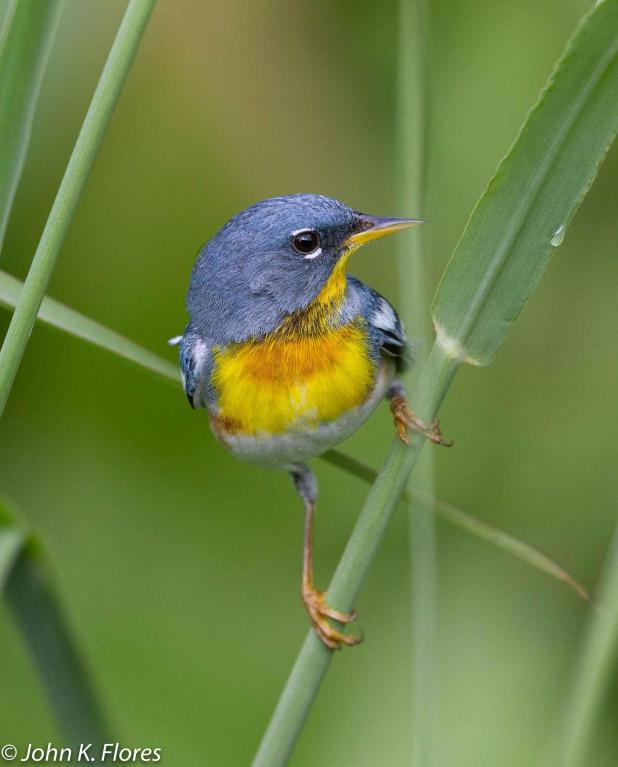
The Northern Parula is one species of songbirds nature lovers can enjoy during the annual bird migration.
The Daily Review/John Flores
Outdoors with John Flores: March is prime time for birding
Louisiana is considered to be one of the Top 5 birding states in the U.S.
The month of March is considered one of those transitional months, when nature lovers can enjoy seeing several hundred species of migratory birds both coming and going. This column is the second in a two-part series on Louisiana birding – the spring migrations.
You’ve got to love social media, where everyone is a photographer, and everyone is a reporter. I particular love it on Facebook birding pages like the Gulfcoast Bird Club, Louisiana Birds and Birdwatching, and the Loose Alliance of Casual and/or Keen Birders of Central Louisiana.
All of these pages have something posted to them each and every day throughout the year. But, come spring “that’s” when things really start to get amped up. Serious birders know, come the latter part of March on into late April the neo tropic songbird migration gets into full swing.
The pages are flooded with sightings of Indigo and Painted Buntings, Rose-breasted Gros-beaks, Scarlet Tanagers, vireos, and a host of warblers. And, nearly each post has a picture proving the encounter, some of which are spectacular.
The thing about neotropic songbirds during the spring migration is many species are arriving in beautiful full mating plumage that can be magnificent. These birds are like the colors inside of a kaleidoscope – simply stunning.
Here in St. Mary Parish, the Northern Parula, Prothonotary Warbler, Hooded Warbler, Indigo Bunting, and Painted Bunting are some of the most colorful that nest locally in late spring and summer.
The spring migration isn’t just limited to neotropic songbirds. There are numerous species of shorebirds that return to the northern Gulf of Mexico. Some are using the Louisiana coastline as a stopover location before continuing their journey to the arctic, while others use it as breeding grounds.
This past week, Erik Johnson, Ph.D., Director of Bird Conservation for Audubon, Louisiana, posted on Facebook sightings of a couple Wilson’s Plovers. The thing Johnson wanted birders to pay particular attention to, were those that might happen to be sporting bands on their legs. What’s more, report them right away.
According to Johnson, Audubon Louisiana in conjunction with Barataria-Terrebonne National Estuary Program, the University of Louisiana-Lafayette, and Tulane University have banded over 350 Wilson’s Plovers to learn more about their breeding success, annual return rates, and responses to coastal restoration projects.
One of the things Johnson mentioned in his post was how a couple of Louisiana’s Wilson’s Plovers were re-sighted along the Pacific coast of Costa Rica during the winter. That information is quite remarkable when considering the distance these beach-birds travel and the challenges this species faces both coming and going.
It’s posts like these that energize birders to break out their binoculars and walk the shorelines of Grand Isle, Elmer’s Island, Holley, and Rutherford Beaches along our northern gulf. There is literally a treasure trove of “life” birds to be had where shorebirds are concerned. Species like Semi-palmated Plovers, various sandpipers, phalaropes, godwits, whimbrels, and Red Knots all utilize our coastline during certain migration intervals.
Where songbirds go, raptors are sure to follow. It’s common to see an influx of raptors and kites migrating north each spring. One of the most exciting birds of prey to see arrive is the Swallow-tailed Kite.
This kite is like a ghost in the bottomland hardwood swamps. Its under parts and head are white and the top of its back, wings and tail are black. The swallow-tailed kite’s sudden presence will leave you awestruck momentarily, then captivated by its grace in flight. It has a sleek falcon-like appearance, with an elegant agility while in flight.
I’ve spotted Swallow-tailed Kites near Centerville, along Highway 317 south of Highway 90 from Alice C Road south to Birch Street soaring over the sugar cane fields. My guess is they are nesting somewhere on nearby Bayou Teche National Wildlife Refuge.
Further south on Highway 317 you’ll come to the North Bend West and North Bend East Units of the refuge. The units offer birding opportunities, where visitors may see both Hooded and Prothonotary Warblers, White-eyed Vireos, Barred Owls, Common Yellow-throats, Carolina Chickadees, Blue-gray Gnatcatchers, Downy, Hairy, and Pileated Woodpeckers, Mississippi Kites, and a host of other local and migrating birds.
Other local hotspots to see a variety of migrating birds are Cotton Road in Patterson, Brownell Memorial Park & Carillion Tower in Morgan City, and the Franklin Unit Trail on Bayou Teche National Wildlife Refuge.
A Great Egret rookery can be seen along the northside of Highway 90, just past the westbound on ramp leaving Amelia. The birds are closely bunched together, where nests can be seen.
This year’s March and April migration happens to be right in the middle of a National health crisis with COVID-19 (the Corona Virus) at the top of people’s minds. With restrictive gatherings and recommendations concerning social distance, and cancelation of local youth sporting events there probably is not a better time to participate in birding activities.
With birding there is hiking involved, typically out in the country that could do a body some good, while getting away from the monotony of staying homebound.
